

A representative sample of the rich archeological heritage of Gualdo Tadino is displayed in a series of rooms in Rocca Flea.
Finds from Early Necropoles
Excavation of the ancient necropoles around Gualdo Tadino began in 1921-8 under Enrico Stefani, but relatively little detail was published. Two of them, at le Cartiere and at San Facondino, were associated with an ancient settlement on Colle i Mori. The third, at Malpasso, was near the site of the later Roman settlement of Tadinum.
Some of the grave goods found during these excavations were exhibited at Villa Giulia, Rome, and are now in the annex at Villa Poniatowski. Other items are exhibited here (see below). However, most of them languished in the deposit of the Sovrintendenza Umbra ai Beni Culturali. This vast collection is finally being restored and catalogued, and the possibilities for its future location are under consideration.
Le Cartiere
This necropolis near the point at which the modern Via Flaminia is crossed by Via Cartiere and Via Ugo Righi Vittore (see the Excursion to Tadinum) was first excavated in two campaigns in 1926-7. The necropolis contained some 129 tombs. Excavations also uncovered what might be the remains of a small sanctuary (4th century BC). (Finds from the nearby Lombard cemetery are described below).
Some of the grave goods from the site are exhibited at Villa Poniatowski. The finds exhibited here came from four tombs:
Tomb 0 (ca. 400 BC)
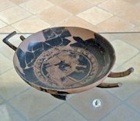
-
✴a laminated bronze curved scraper that would have been used during bathing;
-
✴a bronze implement with seven hook-like protrusions that might have been used for wool working; and
-
✴a bronze jug that was possibly used to measure dry goods such as flour.
Tomb 12 (mid 4th century BC)
This was probably the grave of a man. The grave goods included:
-
✴a kylix that has been assigned to the so-called Sokra Group, which is named for the maker of a cup (375-50 BC) in the Villa Giulia that is inscribed (in the Greek alphabet) “Sokra(tes)”;
-
✴the tip of a lance,
-
✴a bronze jug; and
-
✴an “aes rude” (literally rough bronze), which might have been used as a medium of exchange.
Tomb 28 (early 4th century BC)
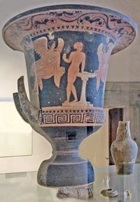
-
✴this red-figured vase , which is decorated by a nude woman leaning on an altar, flanked by two winged figures; and
-
✴a wine jug that has been assigned to the Sokra Group (see above), which is visible to the right in this photograph.
Tomb 49 (ca. 300 BC)
Thus grave contained a black glazed kylix inscribed in Etrsucan “rita” (read from right to left).
San Facondino
This necropolis near the present chrch of San Facondino, slightly to the north of le Cartiere, served the Umbrian settlement on the Colle i Mori (see below). (The sites of the settlement and the necropolis are visited in the Excursion to Tadinum). The necropolis, which was excavated in two campaigns in 1926-8, was structured around two nuclei, one on each side of the so-called strada dei santi:
-
✴One group of tombs was centred on Tomb 5 (7th century BC), which is the oldest found here to date. This part of the necropolis remained in use until the the 1st century AD.
-
✴The other part of the necropolis remained in use over an even longer period, and indeed included some 20 tombs that dated to the Lombard period.
Tomb 5 (7th century BC)
This female tomb was a so-called “tomba a tumulo”, a chamber tomb surmounted by a mound of earth. The grave goods included:
-
✴a group of concentric bronze rings that were probably part of a pendant; and
-
✴a laminated bronze disc decorated by concentric circles of holes.
A rectangular ditch (“Fossa G”), half of which was under Tomb 5, contained a number of clay vases that also date to the 7th century BC. These may have been an associated votive deposit.
Tomb 15 (1st century AD)
The grave goods in this tomb included:
-
✴five clay long-necked vases; and
-
✴a glazed black lamp inscribed “LMCA”.
Malpasso
This necropolis near the site of Roman Tadinum (see the Excursion to Tadinum) was first excavated in three campaigns in 1922-7. The grave goods found in some 65 tombs here indicate that this area was inhabited in the pre-Roman period. The most important finds from this necropolis that are exhibited at Villa Poniatowski. They include those from Tomb 12 (early 4th century BC) which belonged to a richly dressed warrior who had been buried with his weapons and armour (including two bronze helmets) as well as with ceramic items imported from Falerii.
The finds exhibited in the Museo Civico came from two tombs (4th century BC):
-
✴Tomb 2, the grave of a man, the grave goods of which include the tip of a lance and a ceramic vase; and
-
✴Tomb 27, the grave of a woman, the grave goods of which include a ceramic flask.
Boschetto-Ginepraia
Enrico Stefani also partially excavated this necropolis (8th-5th century BC), which is roughly half way between Gualdo Tadino and Nocera Umbra. Most of the finds from the excavations here are exhibited at Villa Poniatowski, Rome and in the Museo Archeologico, Nocera Umbra. Two objects (7th century BC) that were found there were recently donated to the museum:
-
✴a bronze shallow dish; and
-
✴a short iron sword..
Colle i Mori
Finds from Sanctuary (5th - 3rd centuries BC)
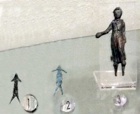
-
✴two schematic bronzes ( 5th - 4th century BC); and
-
✴a female figure making an offering (4th - 3rd century BC).
Finds from the Settlement (5th - 3rd centuries BC)
Excavations in 1992-8 revealed traces of settlement below the sanctuary, which was established on three artificial terraces covering about 5 hectares. It was occupied for about 300 years from the late 6th century BC. It had a fortified circuit that enclosed a number of houses that were apparently composed of several rooms, probably on two floors. It seems to have been abruptly destroyed, perhaps by Hannibal’s soldiers in 217 BC.
The museum exhibits a number of fragments of objects that the people of this settlement would have used in their everyday lives.
Cippus (4th century BC)
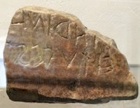
“tarina/ ei tuce st...”
According to Tiziana Capriotti (in entry 37 of the catalogue edited by L. Agostiniani , referenced below):
-
“In all probability, it functioned as a boundary marker for the Umbrian settlement named Tarsino- that occupied the summit of Colle I Mori” (my translation).
Alberto Calderini (in entry 37 of the catalogue edited by L. Agostiniani , referenced below) observed that:
-
“This inscription is of exceptional importance for a number of reasons. First and foremost, it testifies to the [name of ] the Umbrian settlement on Colle I Mori in the 4th century BC ..., and offers a direct confirmation of of the mention of [this community] in Table 1 [of the Iguvine Tables (late 3rd - early 1st century BC)]” (my translation).
In fact, both Table I and Table VIIa describe how Serfus Martius and his associate deities were invoked against the enemies of the Iguvines during the ritual purification of the army. These enemies included:
“ totar tarsinater trifor tarsinater”
(the Tadinate town, the Tadinate territory).
The inscription is discussed in its wider context in the page on Umbrian Inscriptions before the Roman Conquest.
Taino
Architectural Terracottas (ca. 200 BC)
According to Francesca Germini (in P. De Vecchi, referenced below, at p. 167), three architectural terracottas (entries 332-4) that were sporadic finds from Taino (the site of Roman Tadinum from ca. 200 BC), suggest the presence of a cult site here from this period.
Roman Period
Sarcophagus (2nd century AD)

This sarcophagus, which was reused first documented in the cloister of San Francesco in 1872, contains a relief of the deceased held by two winged victories, with figures of Apollo, Minerva, the Ocean and the Land.
Funerary Inscription (2nd or 3rd century AD)
This inscription, which came from Sassoferrato, commemorated Severa, the niece of Virusio Verio, who had died when only three years old.
Lombard Period
Cemeteries in use in the Lombard period have been excavated at Gaifana, Pomaiolo, San Facondino and le Cartiere. Finds from the last of these are exhibited in the museum.
Le Cartiere
Enrico Stefani apparently excavated this site in 1935, when he apparently found evidence of a cemetery that had been use from the 7th century BC until the 6th century AD, along with architectural fragments that probably came from the original church of San Facondino.
Excavations in 1990 found a further eleven Lombard tombs on a part of the site that seems previously to have been a settlement (4th-3rd centuries BC). The museum exhibits grave goods (7th century AD) from a number of these tombs.
Finds from Gualdo Tadino in Other Museums
Inscription (ca. 200 BC) [26]
-
This fragment of part of the right edge of an inscribed bronze tablet was found in 2004 on the site of Roman Tadinum. According to Simone Sisani and Alberto Calderini (referenced below, p. 271 and Figure 1), it was found by local residents slightly to the north of the excavated area here. They speculated (at p. 275) that it might have come from a repository found nearby that contained several hundred metal objects dating from the 6th to the 2nd century BC. They also suggested that the fragment had been removed from the original bronze plaque using five separate cuts in order to arrive at a precise weight (8.6 grams).
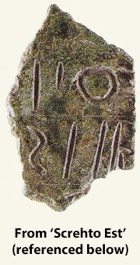
-
Nine letters in the Latin alphabet can be identified on the surviving fragment:
-
...]ofo
-
...]riei
-
...] ot[..]
According to Alberto Calderini (in L. Agostiniani et al., referenced below, p. 34, entry 26), the inscription is probably in the Umbrian language and, according to Sisani and Calderini (at p. 274), it dates to the late 3rd century BC.
Alberto Calderini summarised the analysis from the earlier paper that had identified a possible correspondence betwen the content of this fragment and two formulae used in the Iguvine Tables (from Gubbio): Table Ib and Table VIIa both contained these formulae, both of which described the ritual sacrifice of three red or black pigs. He therefore hypothesised (at pp. 34-5) that this fragment from Tadinum was:
-
“... part of a bronze plaque that described a ritual mirroring the Iguvine sacrifice of ‘PORCA. TRIF. ROFA.’ (three red pigs) ...” (my translation).
He commented (at p. 35) that:
-
“This correspondence removes the [apparent] isolation of the Iguvine Tables, not just because [the fragment from Tadinum] represents a new tabula from Umbria but also in relation to the particular type of content. ... the provenance of [this fragment] is also important in this context: it comes from the closest centre to Iguvium, which was itself mentioned as the tota tarinate in the Iguvine Tables, and it was found ... in the area of the Roman city [of Tadinum]” (my translation).
The surviving fragment is now in the deposit of the Soprintendenza per i Beni Archeologici dell'Umbria, Perugia. The photograph here is from entry 26 of ‘Screhto Est’.
Coin Hoard (69 - 184 AD)

99 silver coins that were found in a terracotta vase (now lost) in 1951 at Grello, some 8 km southwest of Gualdo Tadino. All the coins had been minted at Rome, and those that could be dated belong to the period between the short reign of the Emperor Otho (69 AD) to the reign of Commodus: the three coins from the latter reign date to 184 AD.
These coins are exhibited in the Museo Archeologico, Perugia.
Read more:
L. Agostiniani et al. (Eds), “Screhto Est: Lingua e Scrittura degli Antichi Umbri”, (2011) Città di Castello
S. Sisani and A. Calderini, “Frammento di Tavola Bronzea da Gualdo Tadino”, Studi Etruschi, 72 (2006) 271-8
P. De Vecchi (Ed.), “Museo Civico di Gualdo Tadino: Rocca Flea 2”, (2002) Perugia
Return to Museums of Gualdo Tadino.
Return to Walk around Gualdo Tadino.

